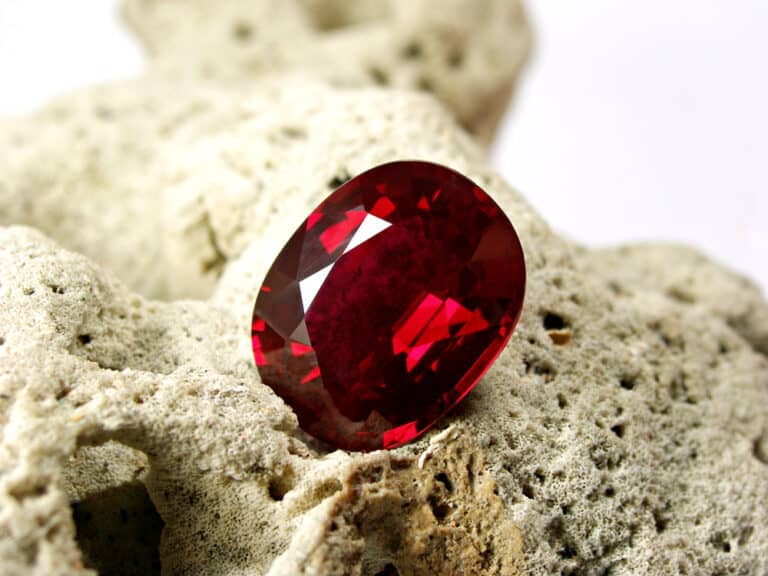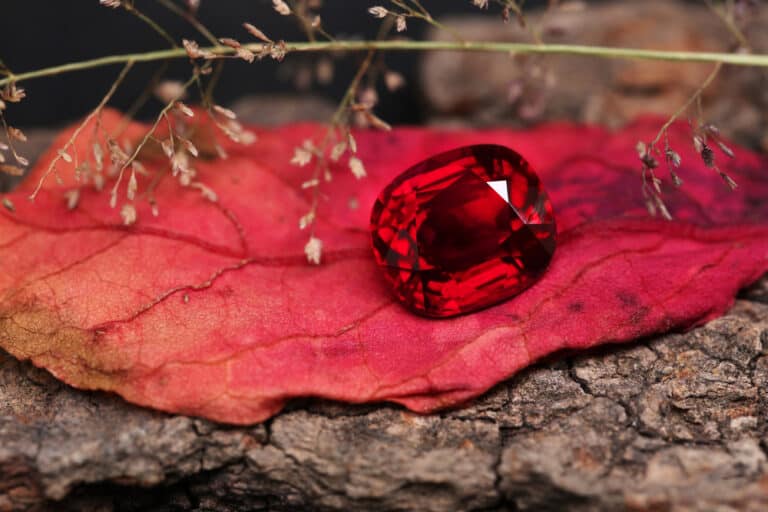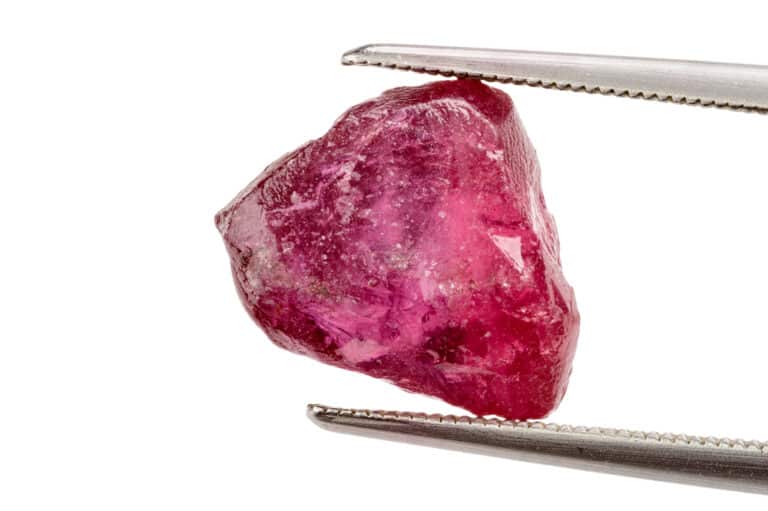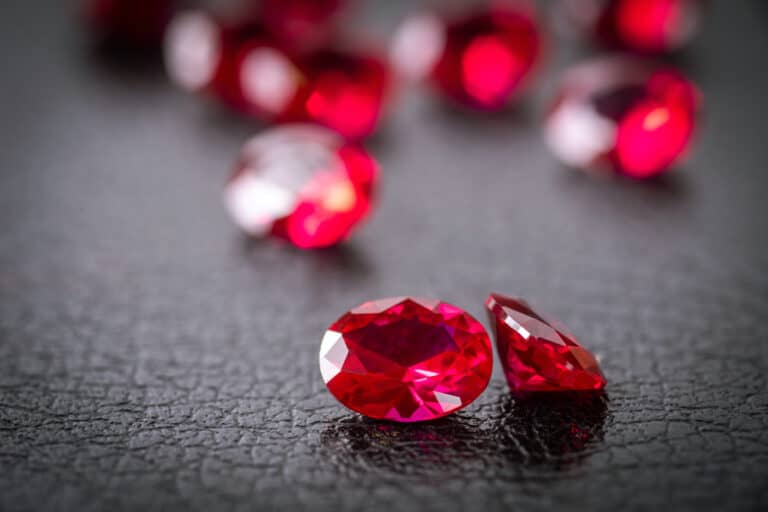At first glance, and especially by an untrained eye, garnets and rubies can seem very similar. After all, they are both red. Or are they? Turns out, there are many differences between garnets and rubies. If you are interested in gemstone collecting or buying a new piece of jewelry, it may be important to know the differences between these two stones.
Rubies are red, but garnets come in many colors. Garnets are made up of silicate minerals with many species and varieties. Rubies, made from corundum with trace elements of chromium, are significantly rarer and more valuable than garnets. The Mohs hardness of rubies is 9, and garnet is 6.5 to 7.5.
Each gemstone has unique characteristics and traits that appeal to the buyer. The qualities you are looking for will determine which stone will be best for you. So, let’s take a closer look at all the differences between rubies and garnets.
What Are The Differences Between Garnet And Ruby?
There are many differences between rubies and garnets, but the most noticeable differences are the mineral composition of each stone, the color, and the hardness. These differences are simplified in the table below.
| Garnet | Ruby | |
|---|---|---|
| Mineral | Garnet Group | Corundum |
| Color | All Colors | Red |
| Mohs Hardness | 6.5 – 7.5 | 9 |
The Composition and Origin Of Garnet And Ruby
The composition of a stone refers to the minerals the stone is made of and the structure of the crystals. A gemstone’s composition will determine its appearance and the hardness of the stone.
The Composition And Origin Of Garnet
Garnets belong to a group of complex silicate minerals. There are roughly twenty garnet species within the garnet group, and while they all share the same crystal structure, each species have a unique chemical composition and features.
Of the twenty garnet species, only five are commonly used. Most garnets are blends of different garnet species. Within each species, there are different varieties.
The five most common species are:
- Spessartine – includes mandarine garnet and kashmirine
- Pyrope – includes chrome pyrope
- Almandine – includes star and color change garnet varieties
- Grossular – includes hessonite, tsavorite, and leuco garnet
- Andradite – include topazolite, demantoid, and melanite
Garnets have a Mohs hardness scale of 6.5 to 7.5, depending on the species and variety. While garnets are not as strong as diamonds and other precious stones, they are hard enough to be suitable for moderate everyday wear.
Garnets are abundant and mined in many countries and are often found in a group of several garnet species or varieties.
Popular mining locations for garnets include:
- South Africa
- Madagascar
- Tanzania
- India
- Arizona
- Sri Lanka
The Composition Of Ruby
Rubies are composed of an aluminum oxide mineral called corundum. Most rubies are found in two geological locations; marble and basalt rock.
Marble often contains very little iron, producing vibrant, deep red rubies with a fluorescent shine. On the other hand, Basalt rocks contain more iron, and the rubies formed in these rocks are darker.
While rubies are found in many regions of the world, most high-quality rubies are mined in Asia. Myanmar is particularly known for producing fine rubies due to the abundance of marble.
Other mining locations for rubies include:
- Thailand
- Pakistan
- Tanzania
- Vietnam
- Himalayas
- Mozambique
Rubies have a 9 hardness on the Mohs scale, outranked only by diamonds and moissanite. Therefore, rubies are excellent for bridal wear like engagement and wedding rings.
Do Garnets And Rubies Have The Same Color?
It may seem that garnets and rubies are both red, but these stones have different colors. Upon closer inspection, you will notice that even the shades and tones of the reds differ.
When comparing red garnet to rubies, there is a noticeable difference in the color and brilliance of the stones. Rubies have a more opaque, almost milky appearance with visible inclusions, while garnets are more “see-through” (brilliant). While fine rubies have more brilliance and are less milky, the red is a purer red than garnet’s yellowish, brownish red.
The Colors Of Garnets
While most people associate garnets with the color red, garnets come in a great variety of colors. Color determines the quality of a garnet!
Due to the wide selection of colors, garnets suit any skin tone, making garnet jewelry extremely popular.
The table below shows the many colors of garnets:
| Variety | Species | Color |
|---|---|---|
| Mandarin | Spessartine | Orange |
| Kashmiri | Spessartine | Yellowish to reddish or brownish orange |
| Rhodalite | A blend of Pyrope and Almandine | Red to purple |
| Chrome pyrope | Pyrope | Dark, deep red |
| Grape garnet | A blend of Pyrope and Almandine | Dark purplish red, like the color of grapes |
| Almandine garnet (most common red garnet) | Almandine | Dark red to reddish brown |
| Star garnet | Almandine | Reddish brown with an asterism effect |
| Color change garnet | A blend of spessartine and pyrope | A variety of different colors, including blue. Changes color in a different light |
| Hessonite | Grossular | Cinnamon |
| Tsavorite | Grossular | Deep, vibrant green |
| Merelani mint garnet | Grossular | Light mint green |
| Leuco garnet | Grossular | colorless |
| Mali garnet | A blend of grossular and andradite | yellow-green to tsavorite green/yellow/gold/brown |
| Topazolite | Andradite | Yellow to yellow-green |
| Demantoid | Andradite | Emerald green, similar to tsavorite |
| Melanite | Andradite | black |
| Colophonite | Andradite | Brownish red to brownish orange |
| Malaya garnet (also called champagne garnet) | A blend of almandine, pyrope and spessartine | Orange to red to peachy pink |
Are All Rubies Red?
Ruby is a fascinating stone. Gemstones formed from corundum come in many colors, but all red corundum gemstones are rubies. All other colors are sapphires.
Rubies contain chromium, which gives the gemstone its red color. Thus, color is one of the quality factors for rubies. Unlike sapphire, rubies have a fluorescence caused by chromium’s presence, giving this gemstone a vibrance like no other! Fine rubies have more chromium trace elements in the corundum.
The presence of iron and other trace elements causes various colors and brilliance in rubies. The less iron is present, the purer the red color.
While garnet is wine red with yellow or brown undertones, rubies have blue or purple undertones.
Are Garnets And Rubies Precious Stones?
Gemstones are divided into two broad categories: precious and semi-precious. Precious stones are extremely rare, high-quality stones and, thus, very expensive. Semi-precious stones, on the other hand, are more abundant.
There are only four precious stones:
- Diamonds
- Sapphires
- Emeralds
- Rubies
Ruby’s rarity and hardness have earned it a place in the precious stone category. While rubies are precious stones, garnets are far more abundant and are therefore considered semi-precious.

Lore, History, And Spiritual Meaning Of Garnets And Rubies
It is interesting to learn the history and lore of a particular stone. Knowing where your stone originated and its stories make it more special. Many people choose gemstones based on their spiritual qualities, as many stones are said to have spiritual effects on the wearer.
Garnet’s Spiritual Meaning, Lore and History
Garnets have a long history as a prized and spiritual gemstone, dating back to Ancient Egypt! Ancient Egyptians believed that garnets protected against death and had the power to heal wounds and diseases.
During the Middle Ages, the Roman nobles wore garnet gems in the signet rings, while nobles highly desired garnets during the Victorian era. Due to garnet’s wine-red color and its use by nobles, garnet is associated with regality and class to this day.
Spiritually, garnets encourage and aid love, passion, loyalty, and protection. Garnets protect vital, life-giving organs like the heart and lungs.
Those celebrating their birthdays in January can proudly call Garnets their gemstone. Garnets are also the stone of choice to celebrate the second wedding anniversary.
Lore, History, And Spiritual Meaning Of Ruby
Rubies date back to about 200 BC. As most rubies are found in Asia, rubies played a significant role in ancient Asian cultures.
The name ruby means “red” in Latin, but in ancient Sanskirt, it translates to mean “king of gemstones .”The ancient Hindus believed rubies to possess mystical powers. A future life as an emperor would await anyone who gifted rubies to their god Krishna.
The color of ruby, reminding of blood, has given ruby symbolism of health, passion, and love. Some believe rubies cure inflammation and offer wisdom, protection, and peace.
Rubies are the celebratory stone for anniversaries of the 15th and 40th years and the birthstone of July.
The Difference In Value Between Rubies And Garnets
We now know that ruby is a precious stone while garnets are semi-precious. From this, it is clear that rubies are more valuable, but how do they compare in pricing?
How Valuable Are Garnets?
Garnet varies in value due to all the species and varieties available. Some garnets are more abundant than others, like red garnets. Compared to precious stones, garnets are far more accessible, and specimens larger than 1ct are common.
Thanks to garnet’s eye-clean appearance, raw garnets don’t need treatments to enhance their brilliance or color. These procedures add to the cost of stones.
The rarest and most valuable garnet species are andradite, specifically demantoid varieties, and spessartites like mandarin garnets.
The Value Of Rubies
Color and quality determine the value of rubies. Deep, vibrant red with a fiery glow is most prized. When it comes to quality, there are commercial-grade rubies that are acceptable for jewelry and commercial uses and fine-quality rubies.
Fine rubies are incredibly rare, and the gems are often very small. Finding a fine ruby weighing more than 1ct is scarce due to the presence of chromium in the stone. Although rubies are very hard, chromium can fracture the stone, making the formation of large fine rubies rarer and more expensive than diamonds.
Unlike garnets, rubies are often treated to reduce imperfections, adding to the cost.
Conclusion
Garnets are available in many colors and sizes, while all rubies are red. If you are looking for a gemstone for jewelry, garnets are ideal for earrings and pendants as they are affordable and easier to replace should you lose one of your stud earrings. Rubies, although pricier, are harder and more scratch-resistant, making them perfect for weddings or other rings.
References
- https://www.angara.com/blog/ruby-vs-garnet-whats-the-difference/
- http://www.differencebetween.net/object/difference-between-ruby-and-garnet/
- https://www.brides.com/gemstone-meaning-5100907
- https://www.americangemsociety.org/birthstones-in-folklore/
- https://www.gia.edu/
- https://www.brilliantearth.com/news/gemstone-meanings-the-surprising-symbolism-of-your-jewels/
- https://www.geologyin.com/2018/03/garnet-group-colors-and-varieties-of.html
- https://www.earthmagazine.org/article/mineral-resource-month-garnet-0/
- https://en.wikipedia.org/wiki/Garnet#Garnet_group_end_member_species
- https://www.gemsociety.org/gemstone-encyclopedia/
- https://www.gemselect.com/other-info/gemstone-meanings.php






